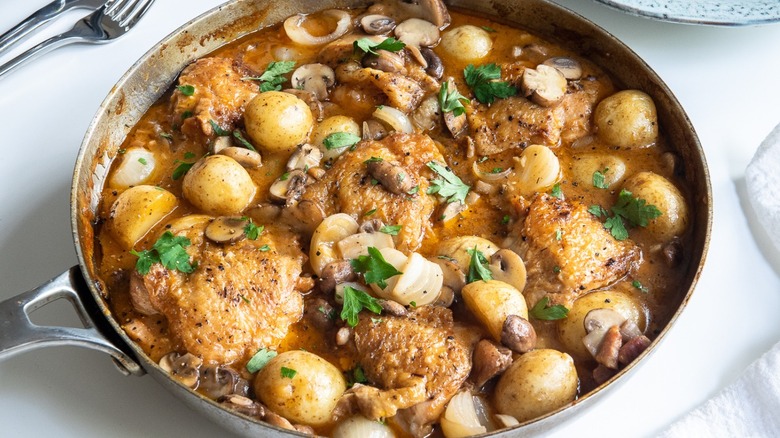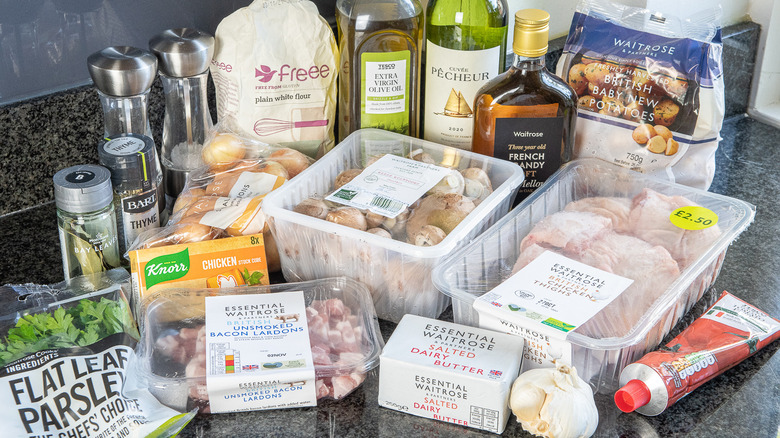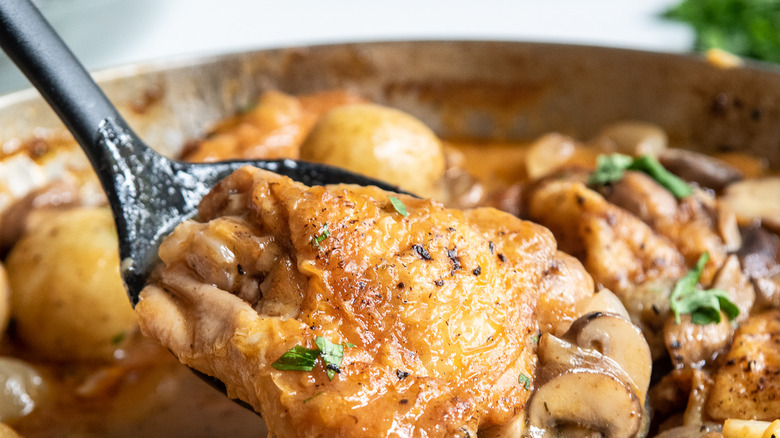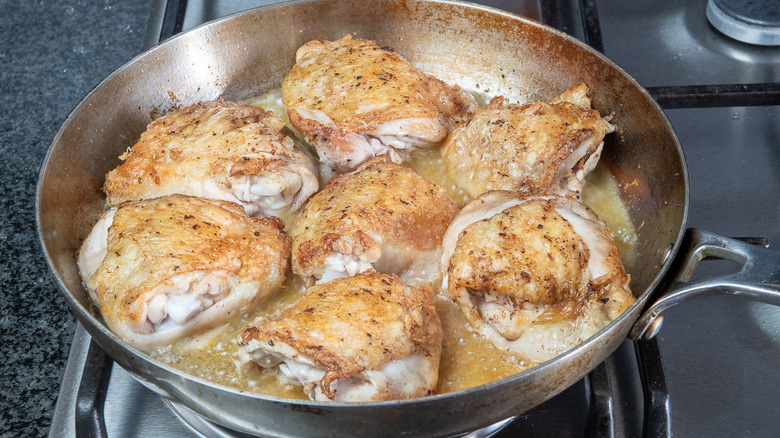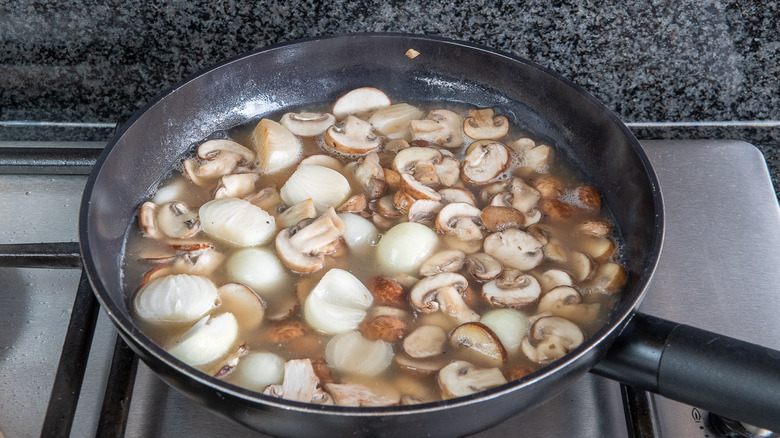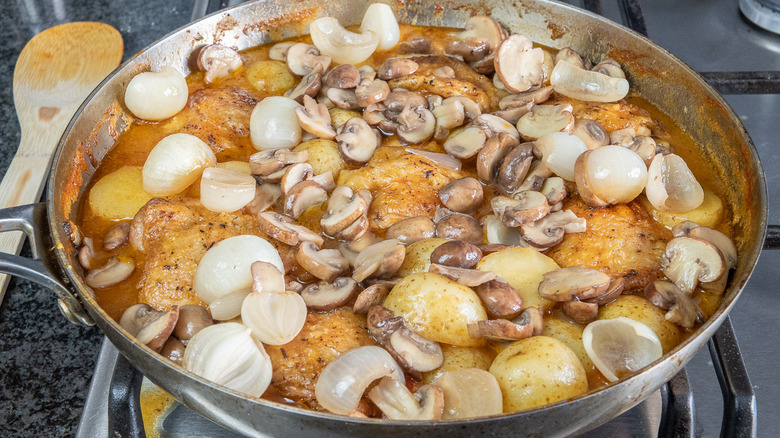Julia Child's Coq Au Vin Recipe With A Twist
If you've ever tried coq au vin, chances are it was made with a nice red wine and was prepared for you at a restaurant by a skilled chef. As a result, this very traditional French dish scares off many home cooks, but don't worry: Julia Child believed in you when she put together her recipe for the classic. And chef and recipe developer Jennine Bryant believes in you, too. Her spin on the recipe adds a new flavor element, while her recipe itself is pleasantly easy to follow, at least so long as you just take your time and go step by step.
"It's not too difficult," Bryant says. "As long as everything is properly prepared beforehand, the recipe itself is quite straightforward. The most challenging part is setting the chicken on fire, which should be done with caution, and can be left out of the recipe if the person cooking doesn't feel comfortable setting things alight!"
Of course, the flaming chicken is also arguably the most enjoyable part of the cooking process, so go for it if you're willing (and also brush up on kitchen fire safety and keep a fire extinguisher nearby, just in case). Check out our recipe for bananas Foster for some important tips on flambéing safely.
Gather your ingredients
We must admit that it takes a good number of ingredients to make a great coq au vin, but the shopping list is well worth it for this excellent dish. And you'll be making Julia Child proud, too, so it's worth it to source everything you need for this classic recipe.
All told, you'll need bacon, butter, frying chicken, salt, and pepper. For liquids, find some cognac, white wine, and chicken stock (or brown stock or beef bouillon and water). You'll also need tomato paste, chopped garlic, thyme, a bay leaf, new potatoes, olive oil, halved small onions or whole pearl onions, mushrooms, flour, and some fresh parsley for serving.
So, what's the twist?
In some ways, this is a pretty traditional coq au vin recipe. You've got wine, you've got chicken, and instructions derived from no less a culinary personage than Julia Child, herself trained in classical French fashion. But in two key ways, it's a significant departure from coq au vins of ages past. "Traditionally, coq au vin is made with red wine rather than white wine," Bryant says. This recipe uses white wine instead, a change that yields a still mightily flavorful yet more delicate dish. This means that the final result should pair well with other foods and won't overpower them, as red wine-based dishes sometimes tend to dominate the plate.
As for the other twist? "This also has potatoes cooked with the rest of the casserole to make it a one-pot dinner coq au vin," Bryant adds. So, if the recipe list made you feel a bit intimidated, know that this meal is just a bit easier to make than the classic (and creates fewer dishes to wash, too).
Fry the bacon and sear the chicken
To start cooking, first heat a deep pan on medium-high heat. Sauté the bacon in a tablespoon of butter, cooking it slowly until the bacon has lightly browned. Then remove the bacon and set it aside, taking care to leave the fats from the butter and bacon in the pan.
Next, dry the outside of the chicken (paper towels work well here) and season it with salt and pepper. Then, sear it, skin side down, in the reserved butter and bacon fat. Cook the chicken until it has turned golden brown, for about 2 or 3 minutes. Then, flip it and cook the chicken until it takes on some more brown color on the other side, or for another 2 minutes.
Once you've achieved this and are ready to flambé, pour the cognac into the pan and carefully set the chicken ablaze. Be sure to let the alcohol burn out thoroughly before transferring the chicken to a separate plate and setting it aside.
Simmer the meat and potatoes
In the same pan, add the chopped garlic, the thyme, and the bay leaf, and stir. Then add the tomato paste and stir everything together.
Now, it's time to add the chicken and bacon back to the pan, as well as 2 cups of the white wine and the stock. All told, there should be enough liquid to just cover the chicken. Add the potatoes, then place a lid on the pot and simmer it for about 25 to 30 minutes. At the end of that time, you'll want to see that the chicken is cooked through, the potatoes are soft, and the sauce has been slightly reduced.
While the coq au vin is cooking, you can multitask a bit and prepare the onions and mushrooms. In a separate wide skillet, add 1 tablespoon of butter and the olive oil over medium heat, then add the pearl onions and mushrooms. Cook the mushrooms and onions for 2 to 3 minutes. Then, add in the remaining wine and sauté the mixture for about 10 minutes, until the mushrooms are soft and the wine has reduced.
Bring it all together and enjoy
To make the beurre manié mixture meant to thicken the sauce, first combine the flour and the final 2 tablespoons of butter in a bowl, stirring to form a paste. Add some of the liquid from the pan to the paste and mix it in, then slowly add it back into the main pan containing the coq au vin. Stir the mixture often, until the sauce has thickened. "You may not need all of the beurre manié, so stir in a little at a time," says Bryant.
Finally, add the cooked onions and mushrooms to the pan with the chicken, adding any leftover liquid that may have come from the mushrooms, and gently combine. Before serving, bring to a slow simmer so everything is heated through. Sprinkle with fresh chopped parsley for a bright pop of color and fresh flavor.
And for serving, Bryant says that you've got plenty of options. "I'd definitely pair this with white wine to match the wine in the casserole, and serve it alongside some fresh steamed greens such as green beans or kale," she says. As for leftovers, place them in an airtight container in the fridge, where they should keep for up to three days. "The coq au vin should be gently reheated, either on the [stove] in a pan with a lid on, or in a microwave," Bryant notes. "Slow and steady is the trick so that the chicken is properly heated through and nothing burns!"
Julia Child's Coq au Vin Recipe with a Twist
The traditional French dish known as coq au vin scares off many home cooks, but don't worry. This recipe is easy to follow and takes a new twist on a classic.
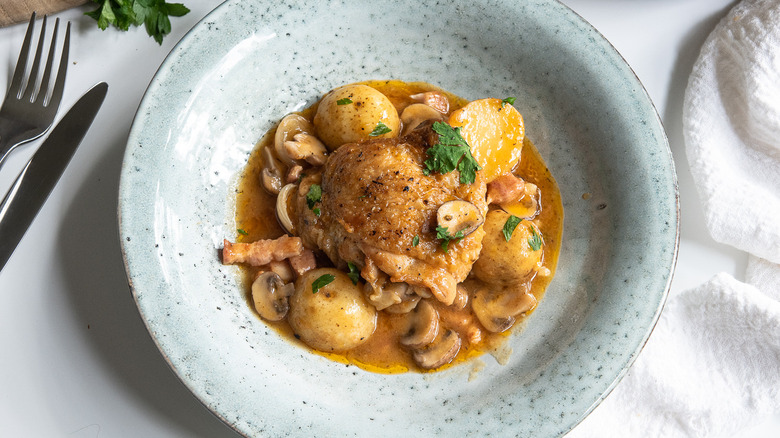
Ingredients
- 4 ounces lean bacon
- 4 tablespoons butter, divided
- 3 pounds frying chicken
- ½ teaspoon salt
- ⅛ teaspoon pepper
- ¼ cup cognac
- 3 cups white wine, divided
- 2 cups brown chicken stock
- ½ tablespoon tomato paste
- 2 cloves chopped garlic
- ¼ teaspoon thyme
- 1 bay leaf
- 1 pound new potatoes
- 1 tablespoon olive oil
- 12 halved small onions or 24 whole pearl onions
- ½ pound mushrooms
- 3 tablespoons flour
- Sprigs of fresh parsley
Directions
- Heat a deep pan a on medium-high heat and sauté the bacon in 1 tablespoon of butter, cooking it slowly until it has lightly browned. Remove bacon and set aside.
- Dry the chicken and season it with the salt and pepper. Sear it skin side down in the reserved bacon fat until golden brown, for about 2 to 3 minutes. Cook on the other side for 2 minutes.
- Once the meat has browned, pour cognac over it and flambé the chicken. Let the alcohol burn out thoroughly before transferring the chicken to a separate plate.
- In the same pan, add the chopped garlic, thyme, and bay leaf, and stir. Then add the tomato paste and stir.
- Add the chicken and bacon back to the pot with 2 cups of white wine and the stock. There should be enough liquid to just cover the chicken. Add the potatoes
- Place a lid on the pot and simmer for 25 to 30 minutes, until the chicken is cooked through, the potatoes are soft, and the sauce has slightly reduced.
- While the coq au vin is cooking, in a wide skillet, add 1 tablespoon of butter and the olive oil over medium heat. Add the pearl onions and mushrooms.
- Cook the mushrooms and onions for 2 to 3 minutes. Pour in the remaining wine and sauté the mixture for 10 minutes, until the mushrooms are soft and the wine has reduced.
- Combine the flour and the final 2 tablespoons of butter in a bowl to form a paste. Add some of the liquid from the pan to the paste and mix. Slowly add this back a bit at a time into the coq au vin until the sauce has thickened. You may not need all of the paste.
- Add the cooked onions and mushrooms to the pan with the chicken and gently combine.
- Before serving, bring to a slow simmer so everything is heated through, then sprinkle with fresh chopped parsley.
Nutrition
| Calories per Serving | 897 |
| Total Fat | 52.8 g |
| Saturated Fat | 17.8 g |
| Trans Fat | 0.6 g |
| Cholesterol | 205.3 mg |
| Total Carbohydrates | 27.1 g |
| Dietary Fiber | 2.8 g |
| Total Sugars | 5.4 g |
| Sodium | 617.7 mg |
| Protein | 50.3 g |
